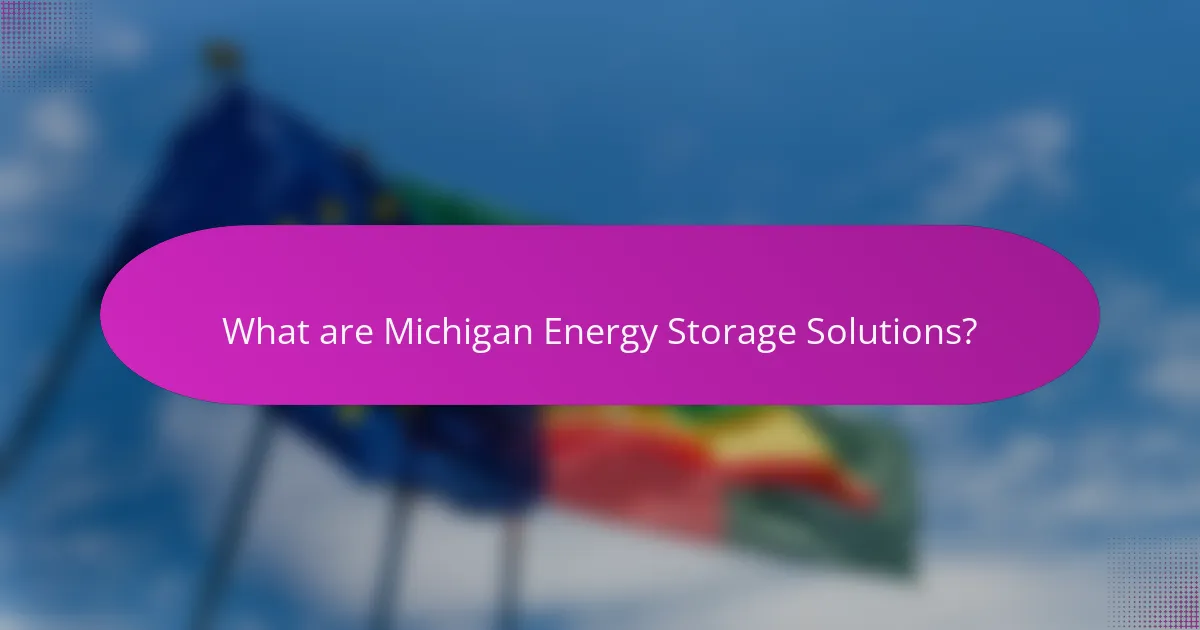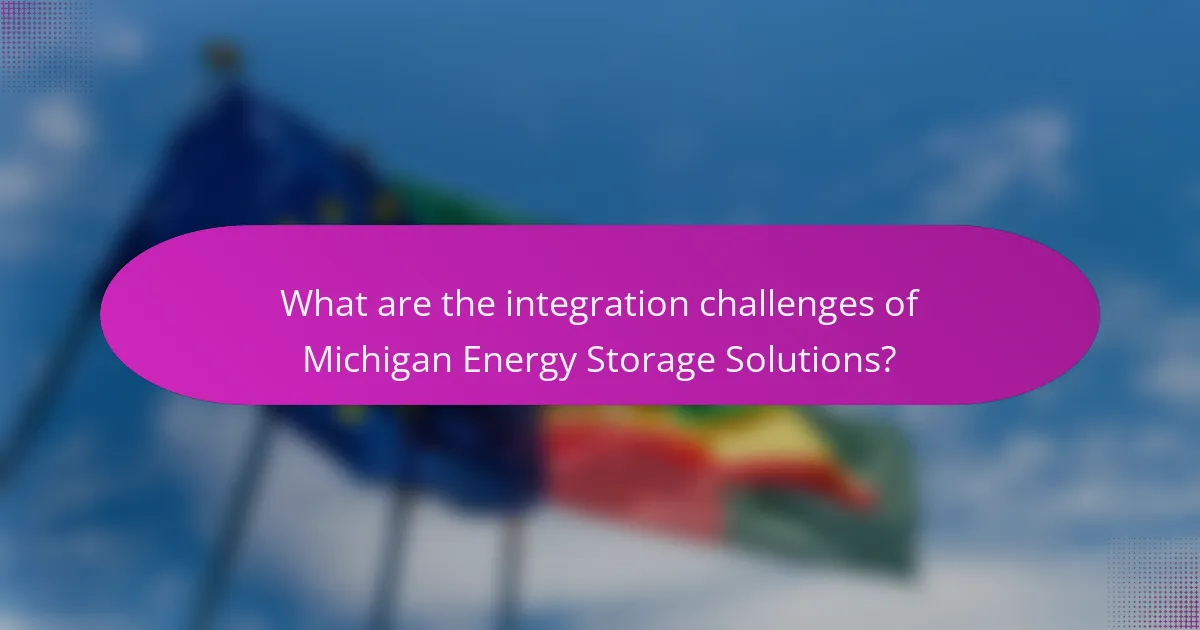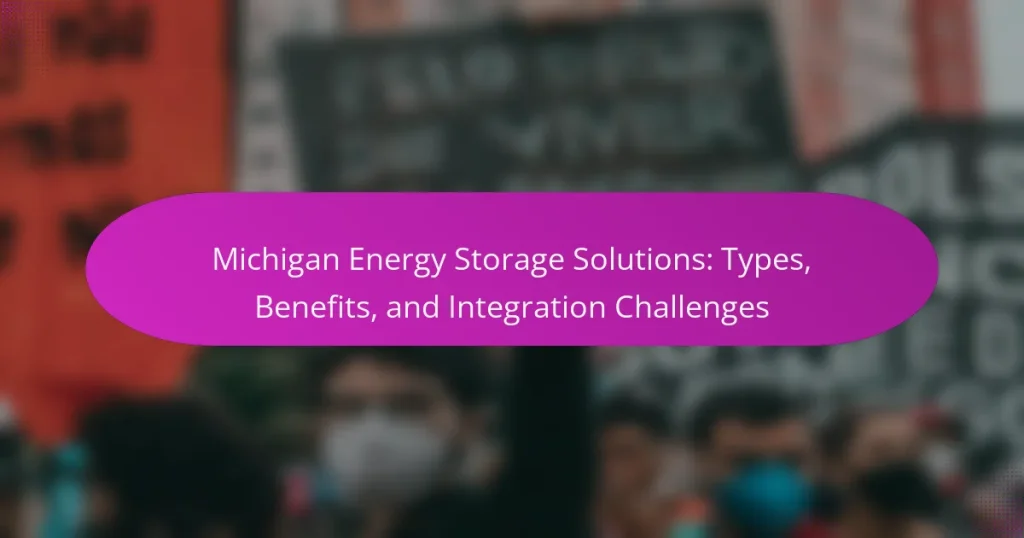
What are Michigan Energy Storage Solutions?
Michigan Energy Storage Solutions refer to technologies and systems designed to store energy for later use within the state of Michigan. These solutions include battery storage, pumped hydro storage, and thermal energy storage. They help balance supply and demand, enhance grid reliability, and integrate renewable energy sources. For instance, battery storage can store excess solar energy generated during the day for use at night. Michigan has invested in various energy storage projects to support its clean energy goals. According to the Michigan Public Service Commission, energy storage plays a critical role in achieving a resilient and sustainable energy system.
How do Michigan Energy Storage Solutions function?
Michigan Energy Storage Solutions function by storing energy for later use, primarily from renewable sources. They utilize technologies such as batteries, pumped hydro, and thermal storage. These systems capture excess energy during low demand periods. The stored energy can then be released during peak demand times. This process stabilizes the grid and enhances energy reliability. For instance, lithium-ion batteries are commonly used due to their efficiency and scalability. Additionally, Michigan has invested in various projects to integrate these solutions into the energy landscape. This integration helps reduce reliance on fossil fuels and supports renewable energy initiatives.
What technologies are involved in Michigan Energy Storage Solutions?
Michigan Energy Storage Solutions involve several key technologies. These include lithium-ion batteries, which are commonly used for their efficiency and scalability. Flow batteries are also utilized, offering long-duration energy storage capabilities. Additionally, pumped hydro storage is a significant technology, leveraging water elevation for energy retention. Compressed air energy storage is employed as well, using compressed air to store energy. Each of these technologies plays a crucial role in enhancing energy reliability and supporting renewable integration in Michigan’s energy landscape.
How do these technologies interact with energy systems?
Energy storage technologies interact with energy systems by enabling the management of supply and demand. These technologies store excess energy generated during peak production times. They release this stored energy when demand exceeds supply. This interaction helps stabilize the grid and enhances reliability. Energy storage also facilitates the integration of renewable energy sources like solar and wind. By smoothing out fluctuations in generation, these technologies support a more resilient energy infrastructure. Studies show that effective energy storage can reduce reliance on fossil fuels and lower greenhouse gas emissions. For example, the U.S. Department of Energy reports that energy storage can enhance grid flexibility and improve overall efficiency.
What types of energy storage solutions are available in Michigan?
Michigan offers several types of energy storage solutions, including lithium-ion batteries, pumped hydro storage, and flywheel energy storage. Lithium-ion batteries are commonly used for residential and commercial applications due to their efficiency and scalability. According to the Michigan Energy Innovation Business Council, these batteries are increasingly deployed for grid support and renewable energy integration. Pumped hydro storage utilizes two water reservoirs at different elevations to store energy by pumping water uphill during low demand and releasing it during high demand. This method is well-established and provides large-scale energy storage capabilities. Flywheel energy storage systems store energy in the form of kinetic energy, allowing for rapid discharge and recharge cycles. These systems are particularly useful for stabilizing the grid and managing short-term fluctuations in energy supply and demand.
What are the different forms of energy storage in Michigan?
Energy storage in Michigan includes several forms such as battery storage, pumped hydro storage, and thermal energy storage. Battery storage systems utilize lithium-ion or other technologies to store electrical energy. These systems can provide quick response times for grid stability. Pumped hydro storage involves moving water between two reservoirs to generate electricity when needed. Thermal energy storage stores excess energy as heat for later use. Each form contributes to balancing supply and demand in the energy grid. Michigan’s energy policies support the development of these storage solutions to enhance renewable energy integration.
How do these types compare in terms of efficiency and cost?
The efficiency and cost of energy storage solutions in Michigan vary significantly among types. Lithium-ion batteries are highly efficient, with round-trip efficiencies around 90-95%. Their cost has decreased to approximately $150-$200 per kWh as of 2023. In contrast, pumped hydro storage has lower efficiency, typically around 70-80%, but offers lower costs, often under $100 per kWh. Flow batteries present a unique case, with efficiencies of about 70-80% and costs ranging from $300 to $600 per kWh. These differences highlight the trade-offs between efficiency and cost for various energy storage technologies in Michigan.

What benefits do Michigan Energy Storage Solutions provide?
Michigan Energy Storage Solutions provide enhanced grid reliability and energy efficiency. They enable the integration of renewable energy sources, such as wind and solar. This reduces reliance on fossil fuels and lowers greenhouse gas emissions. Energy storage systems can store excess energy during peak production times. They release this energy during high demand periods, stabilizing the grid. Additionally, they help in reducing energy costs for consumers. By managing energy supply and demand, these solutions support a more resilient energy infrastructure.
How do these solutions enhance energy reliability in Michigan?
Energy storage solutions enhance energy reliability in Michigan by providing backup power during outages. These systems store excess energy generated from renewable sources, like wind and solar. This stored energy can be deployed when demand peaks or during supply disruptions. For example, Michigan’s energy storage capacity has increased by 300% since 2018. This growth supports grid stability and reduces reliance on fossil fuels. Additionally, energy storage helps balance supply and demand, ensuring consistent energy availability. These solutions also facilitate the integration of more renewable energy into the grid, further enhancing reliability.
What role do energy storage solutions play in peak demand management?
Energy storage solutions play a critical role in peak demand management. They help balance supply and demand by storing excess energy during low-demand periods. This stored energy can be released during peak demand times, reducing strain on the grid. For instance, energy storage systems can lower electricity costs by displacing peak power purchases. According to the U.S. Energy Information Administration, energy storage can contribute to grid stability and reliability. Furthermore, it supports the integration of renewable energy sources, which can be variable. By mitigating peak demand, these solutions enhance overall energy efficiency and sustainability.
How do Michigan Energy Storage Solutions contribute to renewable energy integration?
Michigan Energy Storage Solutions enhance renewable energy integration by providing reliable energy storage that balances supply and demand. These solutions store excess energy generated from renewable sources like wind and solar. When renewable generation is low, stored energy can be dispatched to meet demand. This capability helps stabilize the grid and reduces reliance on fossil fuels. According to the U.S. Energy Information Administration, energy storage can increase the efficiency of renewable energy systems. Furthermore, Michigan’s investments in energy storage technologies are projected to support the state’s goal of achieving 50% renewable energy by 2030.
What economic advantages do Michigan Energy Storage Solutions offer?
Michigan Energy Storage Solutions provide significant economic advantages by reducing energy costs and enhancing grid reliability. They enable businesses and households to store energy during low-demand periods and utilize it during peak times. This practice lowers electricity bills by avoiding high peak rates. Additionally, energy storage systems can defer or eliminate the need for costly infrastructure upgrades. They also support renewable energy integration, which can lead to lower overall energy prices. According to the U.S. Department of Energy, energy storage can save consumers billions in energy costs annually.
How can businesses benefit financially from energy storage solutions?
Businesses can benefit financially from energy storage solutions by reducing energy costs and improving efficiency. Energy storage allows businesses to store excess energy during low-demand periods and use it during peak demand times. This strategy can significantly lower electricity bills. According to the U.S. Department of Energy, demand charges can account for up to 30% of a commercial electricity bill. By utilizing energy storage, businesses can avoid these charges. Additionally, energy storage can provide backup power during outages, preventing revenue loss. A study by the Rocky Mountain Institute found that businesses using energy storage can see a return on investment of up to 20% annually. Overall, energy storage solutions offer significant financial advantages for businesses.
What incentives are available for adopting energy storage technologies?
Incentives for adopting energy storage technologies include federal tax credits, state rebates, and utility programs. The federal Investment Tax Credit (ITC) allows for a 26% tax credit for solar energy systems, which can include storage. In Michigan, the state offers rebates through programs like the Michigan Saves initiative. Utility companies may provide incentives for demand response programs or energy efficiency upgrades. These incentives aim to reduce installation costs and promote clean energy adoption. According to the U.S. Department of Energy, such financial support is crucial for increasing energy storage deployment.

What are the integration challenges of Michigan Energy Storage Solutions?
Integration challenges of Michigan Energy Storage Solutions include regulatory hurdles, technical compatibility, and financial constraints. Regulatory frameworks may not fully support energy storage integration. This can lead to delays in project approvals and implementation. Technical compatibility issues arise between energy storage systems and existing grid infrastructure. These challenges can hinder efficient energy flow and management. Financial constraints impact the adoption of energy storage technologies. High initial costs and limited funding options create barriers for developers. Overall, these challenges must be addressed to enhance the effectiveness of energy storage in Michigan.
What barriers exist for implementing energy storage solutions in Michigan?
Barriers for implementing energy storage solutions in Michigan include regulatory challenges, high initial costs, and limited grid infrastructure. Regulatory frameworks may not support the integration of storage technologies effectively. High upfront capital expenditures can deter investment from both public and private sectors. Additionally, the existing grid may lack the necessary infrastructure to incorporate energy storage systems efficiently. According to a report by the Michigan Public Service Commission, these factors collectively hinder the widespread adoption of energy storage in the state.
How do regulatory frameworks impact energy storage integration?
Regulatory frameworks significantly influence energy storage integration by establishing guidelines and standards. These frameworks determine how energy storage systems can participate in energy markets. They also dictate interconnection requirements and safety standards for storage technologies. For instance, favorable regulations can streamline permitting processes, reducing deployment time. In contrast, stringent regulations may hinder market entry for new technologies. Additionally, incentives and subsidies provided by regulations can enhance the financial viability of energy storage projects. According to the National Renewable Energy Laboratory, states with supportive policies see higher rates of energy storage adoption. Therefore, the nature of regulatory frameworks directly affects the pace and scale of energy storage integration.
What technical challenges must be addressed for successful implementation?
Technical challenges for successful implementation of energy storage solutions include system integration, scalability, and reliability. System integration involves ensuring compatibility with existing energy infrastructure. This can be complex due to varying technologies and standards. Scalability refers to the ability to expand storage capacity as demand grows. Many systems face limitations that hinder this growth. Reliability is crucial for consistent energy supply. Storage systems must operate efficiently under varying conditions. Additionally, energy management systems need to be developed for optimal performance. These systems must accurately predict energy usage and storage needs. Addressing these challenges is essential for effective energy storage deployment in Michigan.
What strategies can be employed to overcome integration challenges?
Strategies to overcome integration challenges include establishing clear communication channels among stakeholders. This ensures that all parties understand their roles and expectations. Implementing standardized protocols can streamline processes and reduce confusion. Utilizing advanced technology for data sharing enhances collaboration and efficiency. Training programs for staff can improve understanding of integration tools and systems. Regular assessments of integration progress help identify issues early. Engaging external experts can provide valuable insights and solutions. These strategies are supported by studies showing improved outcomes in projects with structured integration approaches.
How can stakeholders collaborate to enhance energy storage deployment?
Stakeholders can collaborate to enhance energy storage deployment by forming public-private partnerships. These partnerships can pool resources and expertise to develop advanced storage technologies. Joint funding initiatives can reduce financial barriers for innovative projects. Sharing data on energy consumption patterns can improve the efficiency of storage systems. Collaborative research efforts can drive technological advancements in energy storage solutions. Regulatory frameworks can be developed through stakeholder engagement to streamline permitting processes. Successful examples include the California Energy Storage Initiative, which facilitated collaboration among utilities and technology providers. This initiative led to a significant increase in energy storage capacity in the region.
What best practices can be adopted for effective integration of energy storage?
Effective integration of energy storage requires strategic planning and execution. First, assess energy needs and consumption patterns. This ensures that the storage system matches demand. Second, select the appropriate technology for the specific application. Options include lithium-ion batteries, flow batteries, and pumped hydro storage. Third, implement advanced control systems. These systems optimize charging and discharging cycles, enhancing efficiency. Fourth, consider regulatory frameworks and incentives. Understanding these can facilitate smoother integration. Lastly, engage stakeholders throughout the process. Collaboration ensures alignment of goals and maximizes benefits. According to the U.S. Department of Energy, effective integration can improve grid resilience and reliability.
What are the future prospects for Michigan Energy Storage Solutions?
The future prospects for Michigan Energy Storage Solutions are promising. The state is investing heavily in renewable energy. This includes wind and solar power, which require effective storage solutions. Energy storage systems will help balance supply and demand. Michigan aims to achieve 100% clean energy by 2050. This goal drives innovation in storage technologies. The Michigan Energy Storage Association reports growth in battery storage projects. These projects enhance grid reliability and resilience. Additionally, federal incentives support energy storage development. Overall, the future looks bright for energy storage in Michigan.
How is technology expected to evolve in the energy storage sector?
Technology in the energy storage sector is expected to evolve through advancements in battery chemistry and efficiency. Innovations like solid-state batteries promise higher energy densities and faster charging times. Additionally, the integration of artificial intelligence will optimize energy management and usage. Research indicates that costs for lithium-ion batteries are projected to decline by 50% by 2030. Enhanced recycling methods are also anticipated to improve sustainability and reduce waste. Overall, these advancements will lead to more reliable and cost-effective energy storage solutions.
What role will Michigan play in the national energy storage landscape?
Michigan will play a significant role in the national energy storage landscape. The state is home to a growing number of energy storage projects and initiatives. Michigan’s focus on renewable energy integration drives the demand for energy storage solutions. The Michigan Energy Storage Alliance aims to promote the development of storage technologies. Additionally, Michigan’s manufacturing capabilities support the production of advanced battery technologies. The state has set ambitious goals for carbon neutrality by 2050, which will require robust energy storage systems. Recent investments in energy storage infrastructure further enhance Michigan’s position in the national market. The collaboration between state agencies and private companies fosters innovation in energy storage solutions. Overall, Michigan is poised to be a key player in advancing energy storage on a national scale.
Michigan Energy Storage Solutions encompass various technologies and systems designed to store energy for later use, including battery storage, pumped hydro storage, and thermal energy storage. These solutions are essential for balancing supply and demand, enhancing grid reliability, and integrating renewable energy sources. The article outlines the functions of these storage systems, the key technologies involved, and their benefits, such as improved energy efficiency and reduced reliance on fossil fuels. Additionally, it addresses integration challenges, economic advantages, and the future prospects for energy storage in Michigan, highlighting the state’s commitment to achieving clean energy goals.


